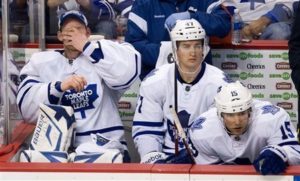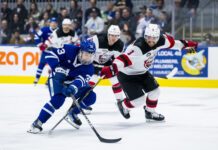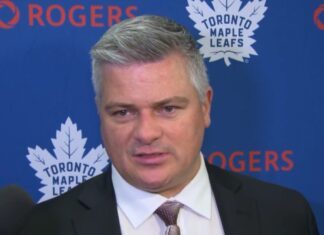
Hockey is not a sport without its politics.
If there’s one thing HBO’s 24/7 has briefly shown its viewers, it’s that there is a lot of things that go on behind the scenes that affect roster decisions, play, signings and so on that a lot of the times we generally never find out about.
On that note, simply judging a roster decision, a player choice, a line combination and one single game is nearly the equivalent of judging the entirety of an iceberg, just by simply looking at what you can see above water. As many of you know, there’s a lot more than meets the eye.
That’s why playoff hockey is so great. By the time teams hit playoffs, it’s not so much about contracts, status, style points, or whatever, it’s about winning. It’s pure hockey.
So why is this all being brought about? That’s simple, it’s James Reimer. He hasn’t had a great year, Jonas Gustavsson has better numbers across the board, the Leafs are in the thick of a playoff race, and yet Reimer is still starting over Gustavsson.
The facts are this, though. Jonas Gustavsson is now in his third year here, he’s turning 28 in October, he needs a new contract this summer and the organization announced that Reimer was their man moving forward. That’s what it all comes down to. James has a three-year deal in his pocket, the organization’s full support as the “golden guy” moving forward, numbers that are below Gustavsson’s but not by a lot, and he’s only turning 24.
So this isn’t a “Ron Wilson” thing, as many like to paint it, this is “how the (business side of the) NHL works” thing.
Let’s look at some examples, shall we.
Colorado traded a first and second round draft choice for Semyon Varlamov this summer and he’s responded with a .900sv%, 2.96GAA and a 15-18-2 record. The Avs also signed JS Giguere this summer and he’s put up a .923sv%, 2.13GAA and a 14-9-2 record. Unlike Reimer-Gustavsson, Giguere’s numbers are substantially better than the organization’s anointed number one, yet there is Varlamov logging more starts than Giguere, even though Colorado is in the thick of a playoff race, or at the very least, trying to give Washington as bad a first round pick as possible. Why? Because he’s the organization’s number one. He’s the guy they are moving forward with for the next three plus years, not Giguere.
In St. Louis, their undisputed number one is Jaroslav Halak. He had a brutal start to the season and was as big a reason as anyone that they fired their head coach early on. Meanwhile, Brian Elliott has consistently been fantastic this year, he has a .940sv%, 1.56GAA and a 20-6-2 record. While Halak has turned around his game, .923sv% a 1.96GAA 16-10-5 record. Still very good numbers, but not what Elliott’s doing. So why has he played more games? Because he’s the guy. Halak has the big money contract in St. Louis and they kept throwing him out there to find his game no matter what Elliott did.
I once was told there are numerous NHL-starting-material goalies all throughout various leagues, whether that be in the AHL, Europe, whatever. This is something that the hockey-world repeatedly learns whether it be Tim Thomas coming out of nowhere to win the Cup, or Joey MacDonald’s current .934sv%, 1.66GAA and a 6-1-1 record in eight games after being cast off by Detroit and three other teams before finding his way back to Detroit.
The difference with a lot of these guys comes down to pedigree, demeanor, off-ice happenings, timing and generally speaking a team’s belief in you. Goaltending is the hardest position in sports and teams don’t take it lightly. Then you add the fact that there are only 30 starting positions and that makes it a mess of ability, politics, stature, and everything in between.
The grass isn’t always greener on the other side. In Philadelphia as soon as things go south everyone blames the goaltending, in Toronto, it’s the coaching. Wilson runs this team like any other coach runs his team. You may not like it, you may not agree with it, you may not care. But it is what it is. Ownership, management, and his bosses have clearly laid out who their guy is. Even though Gustavsson has been better, he hasn’t been drastically better, he hasn’t even been just better; he’s simply been marginally better, if that.
So with all that in mind, Wilson is going to start the guy whose barely-but-not-really played better than the younger goalie whose been hurt, played well in bunches, and is going to be the number one goalie moving forward?
There’s a reason they haven’t named Gustavsson the full-out starter at any point even though he probably deserves it – they are clearly waiting for Reimer to take over the net no matter how long it’s going to take. This is how pretty well every other team who thinks they have a young number one operates. Like I said, you don’t have to like it, but at least understand it.
Regardless of whether Gustavsson or Reimer brings them to the playoffs this year, this team isn’t a contender. But two, three years from now when the Leafs do plan on being contenders, they envision it with Reimer starting between pipes. That’s what this is all about.
***
– On Sunday Garrett did some great work looking at the Leafs record vs. playoff teams. I decided to take it one step further and look at how the core players on the team fared against those teams. There were four players I picked – Dion Phaneuf, Joffrey Lupul, Phil Kessel, and Mikhail Grabovski. I consider Gardiner a core player but I don’t think it’s fair to properly evaluate his work for the full season since it’s his first year and he hasn’t been trusted with big duties throughout the season. I also don’t think it’s fair to look at Carl Gunnarsson’s point totals against top teams because they don’t ask him to do that. As for Connolly and Bozak? They’ve split time on the top line, so their responsibilities have varied throughout the season and looking at point totals with that in mind just didn’t cut it for me.
So here are the stats:
Dion Phaneuf:
4 goals, 7 assists, 13 points total, prorate to 36 points over a full season, -13 rating in 29 games
Joffrey Lupul:
13 goals, 14 assists, 27 points total, prorate to 76 points over a full season, -10 rating in 29 games
Phil Kessel:
14 goals, 20 assists, 34 points total, prorate to 96 points over a full season, -5 rating in 29 games
Mikhail Grabovski:
10 goals, 7 assists, 17 points total, prorate to 51 points over a full season, -6 rating in 27 games (he missed two games, unlike anyone else here)
So what are we learning here?
– Phil Kessel is the only player who beats his current prorated totals. The four other players fall short of what they are currently on pace for. This is one thing I’ve appreciated about Phil Kessel in his time here – he has no interest in padding his stats against terrible teams. The Leafs have had some huge games against Tampa Bay, Washington and so on, and Kessel is not a guy who tries to go out there and get an extra goal or two with five minutes left in an out-of-hand game. I appreciate that. He saves his best for the best teams which is what makes him a fantastic game breaker. For the record, this falls in line with the rest of his career: 15 points in 15 NHL playoff games, 19 points in 21 World Junior games, and so on. He’s a gamer. There’s something to be said about the rest of his game, but in a tight battle, he has the ability to go out there and score on a whim which is what the best game breakers are able to do.
– The minuses for each player are obviously dreadful and all of them had specific games that really hurt their overall number, but I’m not excluding any of it. Some people look at stats and ask “well, what if you don’t include games against Boston” or whatever. But guess what? Boston is a playoff team, and a damn good one. They count just as much as anybody else does. As we’re seeing the Leafs get it handed to them against Vancouver and Calgary this week, it’s clear this isn’t simply a “versus Boston” thing, it’s a team problem.
– The minuses are also a result of these guys all over compensating against top teams. Essentially, they seem as if they are in way over their heads because they don’t get much support from the rest of the roster, so they try and do it all themselves. It’s a lose-lose all around.
– In the big scheme of things, if you look at these stats, you can count on the top line to get you a goal more or less any time you play a top team. You can also count on Grabovski somehow chipping in a goal around two out of three times you play a good team and you can count on Phaneuf to chip in here and there. Other than Phaneuf’s offensive production, isn’t that what you count on from your top two lines? How many teams have two point per game lines? You count on a goal or so from your top line, and a more than likely goal from your second, which is fair when you think about it.
– So, I wanted to show that at the end of the day, the Leafs depth against top teams kills them. They just don’t offer support for the top two lines. The third line isn’t big, or physical, or grinding, or great defensively. Essentially, they are just a substantially worse version of the top two lines, so really, in no way do they support them or help them win against good teams.
– Take the game against Vancouver as a great example. Game starts with the top line getting a two on one in their first shift, but they don’t covert. Couple of shifts later, Keith Aulie makes a head scratching pinch and it’s 1-0. So already they are behind the eight ball and start pushing up for a goal and that leads to 2-0 off a nice diving play by Manny Malholtra that should have been stopped by either the defence, the goalie, or both (it was a two on two with Maxim Lapierre and Malholtra, that should pretty well never result in a goal). The third goal they were on for, but they take part in the blame for that one since it was an entire defensive lapse. But then Kessel, against one of the best teams in the league, essentially goes end-to-end, circles behind the net, and threads the needle to Dion Phaneuf who makes the score 3-1. Now the top line starts building momentum as Lupul and Kessel both miss point blank opportunities. Even with that, the momentum clearly seems to be shifting. Then what happens? Clarke MacArthur steps on the puck and falls leading to the 4-1 goal, then Matthew Lombardi fans on a puck he had five seconds to get out, leading to 5-1. Game over.
– Sure the top line was on for three goals, but two of them they had very little to do with and they did score their own goal as well as create numerous other chances. Because there’s no checking line, they are forced to go against the Canucks top line head to head (something they aren’t suited for), while at the same time the other lines aren’t scoring, or hitting, or really even building momentum. That’s not to say every other player that isn’t on the top line is utterly useless – Mikhail Grabovski, Mike Brown, and Dave Steckel contribute quite a bit in varying roles and degree – but after that, there’s a lot of interchangeable pieces that aren’t necessarily helping the Leafs win games against top teams at the moment. There needs to be a little more clarity in the Leafs lineup to help them make the most out of what they have.
– Even though it was “only” the Oilers, the Leafs lineup actually looked it’s best this week when Connolly was playing right wing with MacArthur and Grabovski and Kulemin dropped down to play with Armstrong and Lombardi. At least with this setup, MacArthur-Grabovski-Connolly are all offense and the third line has two big wingers who could theoretically cycle and grind out shifts with Kulemin and Armstrong. Plus, with these combos there’s more definition to the lineup instead of trying to spread the wealth that doesn’t exist.
– In the first period against Edmonton, Connolly sent some shots at net, had a little extra time to look up and make plays and was dangerous. When he got shifted to the third line in the second period, he looked disinterested and did very little the rest of the game until scoring in overtime when he was back playing with a good player in Joffrey Lupul.
– Having a talented player in Connolly play on the third line is a waste of everyone’s time. Say what you want about Tim, but he has skill. Playing him with Lombardi and Armstrong – two guys who don’t exactly rack up points – is not putting Connolly in a position to succeed. The third line is for guys who work hard and do a lot of things right on the ice, but struggle to score. That would be Nikolai Kulemin right now. I’m surprised the coaching staff keeps going back to this empty well.
– Nobody on the Lombardi-Connolly-Armstrong line recorded a shot on net against Vancouver.
– Another way the Leafs aren’t putting themselves in a position to succeed is on defence. Carl Gunnarsson is a key cog in this group, there’s no avoiding or denying that. So when he goes down they put Mike Komisarek with Phaneuf and when that doesn’t work, it’s Keith Aulie.
– Bobby Holik – who writes an excellent blog everyone should read – wrote about the succeess of the Detroit Red Wings as an organization, in it he wrote this:
One hallmark of the Wings is their ability to identify a player—s strength and put him into a position or role to succeed in. This is certainly not always the case with many other NHL teams, where too many teams try to have a player play against strengths. I always try to explain to younger players that long successful careers are not only for top players. Role players with the right attitude, work ethic and good coaching can make impact in the NHL for many years. Tomas Holmstrom is an example of this.
That more or less sums up what I’m talking about with Tim Connolly. Playing with Lombardi and Armstrong is not helping him be the player he can be, and neither is playing MacArthur and Grabovski with a guy who has six goals. Kulemin is good defensively and is a big body, but at the end of the day he’s playing in the top six and is on pace for 33 points.
– Kulemin also had his best shift of the season on the third line against Calgary in the second period. He drew a penalty, won three battles, and got robbed on a wraparound attempt. He looked much less out of place on the third line and simply just worked hard.
– When Liles was hurt, the Leafs paired Gunnarsson-Phaneuf on the top power play unit and played Jake Gardiner-Cody Franson as the second unit. Although the two defencemen are both better on the power play, they wanted to build their chemistry and keep them together even when Liles came back, so when the veteran returned they seamlessly placed him back on the top unit. They took some growing pains with their power play in the mean time, but it was only a very narrow part of the game being affected, so it was a reasonable thing to do. That’s not the case by putting Komisarek or Aulie with Phaneuf to play against top lines. That’s a huge part of the game, or as we saw against Calgary and Vancouver, that could be the entire game.
– Mike Komisarek has had some bright spots this year, but he’s also struggled mightily and has been a frequent healthy scratch, so the plan is to play him against Jarome Iginla when he steps back into the lineup? Keith Aulie couldn’t make this team out of training camp, he couldn’t stick once he got called up the first time and he’s generally struggled all season, even in the AHL. So play him against the Sedins? Komisarek stepping up on Iginla, who simply passed it over to Tanguay for a quick two on one that Jokinen buried, is an easy goal for that line. Keith Aulie pinching on one Sedin only for the other one and Alex Burrows to breakout for a two on one of their own is another easy goal. So the Leafs this week played against playoff teams and awarded them easy goals. Against top teams, in their home arenas, out west versus other team’s best players, the Leafs made it easy on them to build up leads.
– Both games saw Gardiner eventually move up to the top pairing to play against the other teams best in a case of too little, too late. Would Gardiner-Phaneuf have shutdown the top line of Calgary and/or Vancouver? Who knows. But, they would have had a better chance than Komisarek/Aulie-Phaneuf when you look at all three players’ body of work this season. The one catch if they put Gardiner-Phaneuf together is they then have to split up Liles-Franson to the tune of Liles-Komisarek/Schenn and Schenn/Aulie-Franson. Is not mixing up all the pairings really worth having Komisarek or Aulie play against the other team’s best? It’s just logic I don’t understand. These are rosters moves that seem a little comfortable for a team that’s fighting for a playoff spot.
– One guy worth noting this week was Cody Franson. He played 21:03 against Edmonton which was his highest time on ice since the last time the Leafs played Edmonton (he played 21:34 that game). Those are the only two games this year where he has surpassed 20 minutes of ice time. Last season he only played 20 minutes once and it was literally clocked at 20:00. In his rookie year he didn’t play 20 minutes at all.
– 20 minutes is a bench mark for defencemen; if you’re able to play at least that amount each night, you’re a top four defenceman. Generally speaking, if you’re a defenceman playing 18-19 minutes a game that means you are probably played as a top four defenceman, but you aren’t a true one because your time on ice will fluctuate due to style of play, quality of opponent and so on – think Carlo Colaiacovo.
– So now that begs the question of what Cody Franson’s ultimate potential really is. We know this about Franson: He’s big, he has a cannon of a shot, his passing ability is second to none – springing Lombardi on this breakaway was effortless for him – his skating is weak, his defensive intensity leaves something to be desired and generally speaking he’s a player who leaves you wanting more. Here’s the thing: defencemen take a long time to develop. We’ve seen some young kids come up and excel right away – Cam Fowler, Tyler Myers, etc. – but almost none of them have come in and played well throughout their career without having at least one bad season. They’ve either had a good start to their career then hit a rough patch in preceding years, or started slowly then built up their game. Franson is somewhere in between because he’s been sheltered throughout his time in the NHL and played a lot of “easy minutes” against weaker opponents and in offensive situations.
– So all things considered, over a full season he’s on pace for 33 points after a bumpy start to the year, not a tremendous amount of power play time and a rotating group of partners that really aren’t a great fit for him (remember the Komisarek-Franson tandem?). So is it fair to say that those 33 points could turn into say, 40, two years from now? There were 28 defencemen who hit 40 points last season. What if we push that number to 45 points? There were 18 who did that. What if it takes Franson three years to hit 45 points? Should the Leafs be willing to wait that out?
– We can say this about Franson: his game is improving. He looks a lot better right now then the player we saw late in October. He’s begun taking the body more than he ever has, including a couple decent sized hits. He makes a strong outlet pass to the speedy Leaf forwards, and when Toronto is down in a game his ice time dramatically increases for a reason. Franson needs a new contract this summer, he’s turning 25 this year and his development curve has been slow, but steady. There have been a lot of calls to trade him and/or package him in a bigger deal, but he does present a lot of offensive value and production in a very attractive physical package. He’s an interesting player all in himself and is someone to monitor moving forward. Franson could bring in immediate return, but three years from now could be making the Leafs regret it big time.
– It’s a radical statement that in the beginning of the year Jake Gardiner was paired with Mike Komisarek so that the elder Komisarek could serve as a veteran mentor and safety net for the young rookie. Five months later and Komisarek gets paired with Gardiner so that the still young rookie can keep Komisarek out of trouble and lead the pairing. Speaks volumes about both players.
– Gardiner played 23:18, 24:18 and 26:17 this week. He’s adjusted his game very well as the season has gone on. Early on he was using his speed to get him out of trouble, as you would notice him twisting and twirling and getting out of jams with his legs. Now, you rarely see him in that much of a panic or bad situation where he has to try to use his speed to bail himself out. Gardiner is figuring out the NHL very quickly and learning how to properly position himself for strong outlet passes and use what’s given to him. For example, he had the puck in his own zone against Vancouver in the corner and turned to give it to Schenn cross ice, but it was clear that was never his intention, because as soon as the oncoming forward flinched he turned up-ice and skated it out himself. That just shows Jake’s confidence in his ability now. Earlier in the year he was ceding the puck to veterans like Komisarek even though Gardiner himself is a much better option to make a play with the puck on his own.
– I brought up the idea of a Gardiner-Phaneuf pairing for the future months ago. I’m still thinking it’s a very good possibility to happen… if not this year, then in the years to come.
– Vancouver is the fourth-best team in the faceoff circle, so it was interesting that the Leafs centers numbers were as follows: Bozak 9/15, Grabovski 8/12, Connolly 7/11, Steckel 5/15. That’s probably the most positive thing I can say about that game.
– Talked about the goalies puck handling last week and it came to fruition against Edmonton with a direct goal against. It scares defencemen when your goalie struggles at handling the puck. It’s almost the equivalent of a race for an icing except you don’t even know where the puck is going to go or what’s going to happen.
– Didn’t agree with benching Colby Armstrong for a second straight game considering they lost the first one to the Habs handily. But then he plays two games and doesn’t even record a shot on net. The Leafs are in a tough spot with him because he’s a high paid, well liked veteran, who has battled injury but isn’t doing anything productive when he’s on the ice.
– Joey Crabb isn’t a better player than Colby Armstrong, but right now he is. Are they going to get him back in the lineup anytime soon? Crabb played one game this week, against Calgary, and his 14:36 TOI was higher than any single TOI Armstrong has logged this year (16 games).
– Schenn played 21:10 against Vancouver. Yes, the game was a blowout, but it was still interesting to see the coaching staff play him that much. That’s his highest ice time since the December 23rd game against the Islanders. The only goal he was on for was Daniel Sedin’s, when MacArthur fell on the puck and there wasn’t much you could blame on Schenn for that (he stepped up on Henrik Sedin, but with such a quick turnaround in the play he did the only logical thing – take the guy closest to him who has the puck). Bottom line with Schenn is that he held his own against Vancouver and looked like he was on his game.
– With Gunnarsson back now, I expect the pairings to be Gunnarsson-Phaneuf, Gardiner-Schenn, Liles-Franson moving forward. Anything less wouldn’t make sense.
***
Being the week before the trade deadline hits, figured it was a good time to take some questions and do a Q&A. So send in your pre-deadline questions and I’ll see what I can do.

































